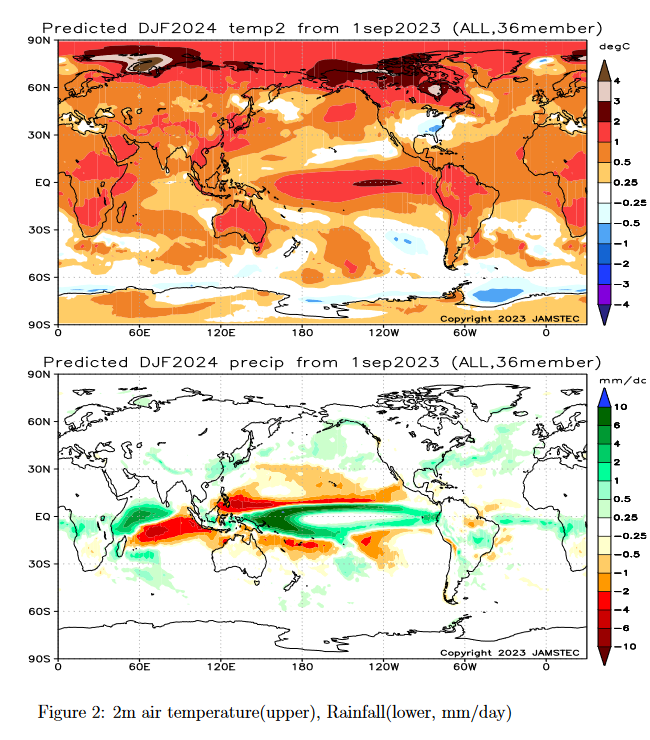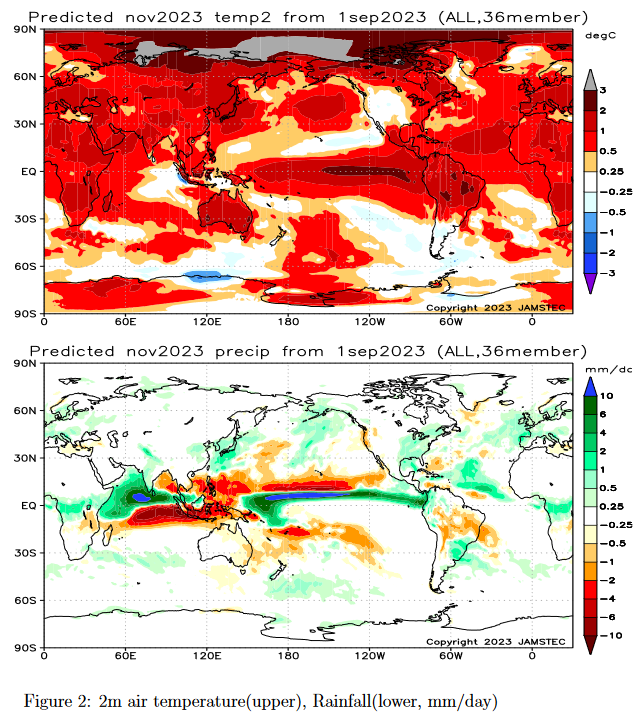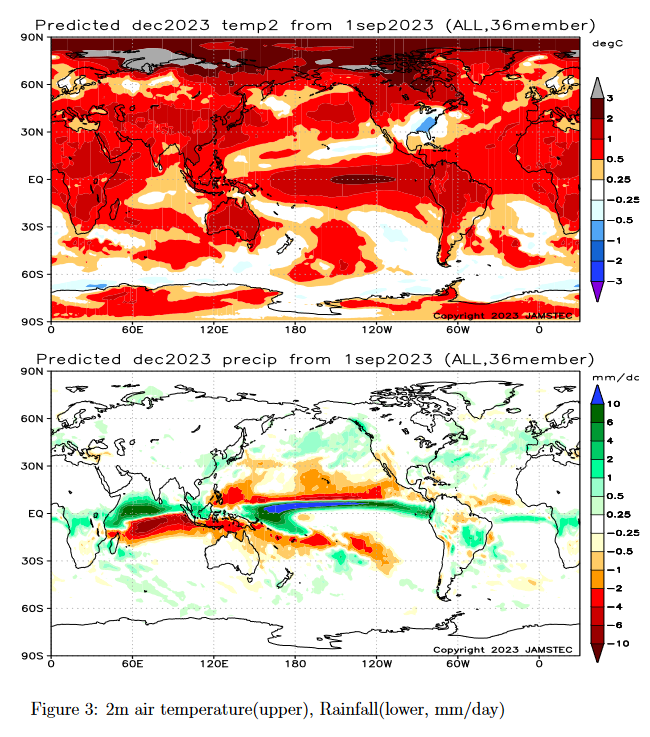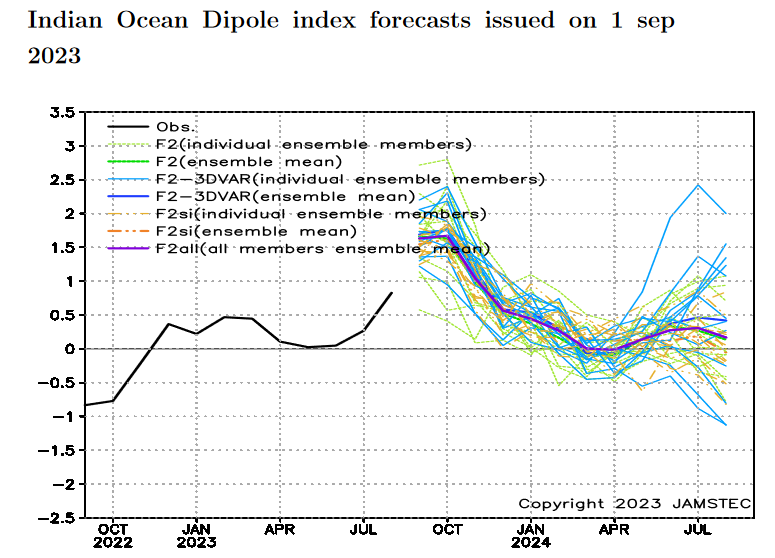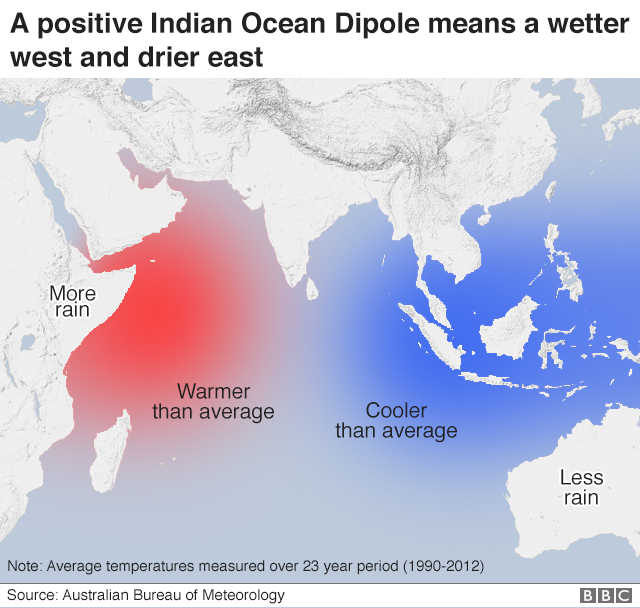
The Japan Agency for Marine-Earth Science and Technology, or JAMSTEC, is a Japanese national research institute for marine-earth science and technology
From the JAMSTEC Discussion:
As predicted, the recent observation confirms the occurrence of the El Niño. The SINTEX-F ensemble mean predicts that the El Niño will reach its peak in the late boreal autumn and persist at least until the next boreal spring. However, there is a large uncertainty in the predicted amplitude.
Although it is a World forecast, it includes a forecast for North America since North America is part of the World. The JAMSTEC discussion does not address it but the maps show the U.S. being an area that has a lot of area that is not warmer than Climatology which I interpret as a fairly cold winter but surprisingly dry in the Southwest.
First, we take a look at the forecasted sea surface temperature anomalies (SSTA). JAMSTEC starts by forecasting the SSTA and Nino 3.4 Index on the first day of the month and from there it usually takes their models about two weeks to produce their seasonal forecast. I received it from JAMSTEC on September 12, 2023 which is a week earlier than when we will receive the Seasonal Outlook from NOAA which will be on September 21. The JAMSTEC model runs are based on conditions as of September 1, 2023. The NOAA Seasonal Outlook will be based on conditions closer to the time when it is issued.
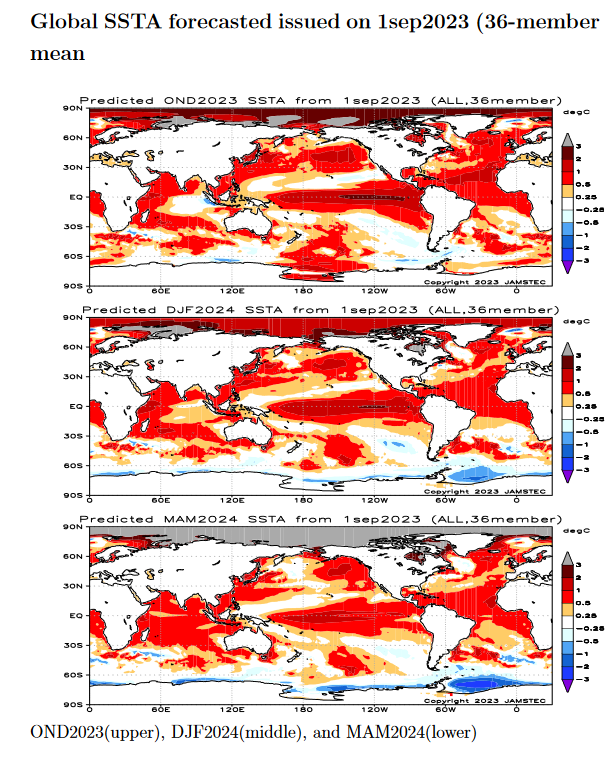
| This shows their forecast of sea surface temperature anomalies at three points in time. Red is warm and is associated with El Nino. You can see the El Nino tongue of warm water extending from Peru to the west in all three time periods. It seems to be stronger in the 1st and 2nd time periods. The warmest water shifts west in the third period exhibiting Modoki characteristics.
JAMSTEC (and also NOAA) are showing very warm oceans. I have written about that before. It raises questions about the reliability of our current approach to thinking about the ENSO Cycle. This is covered in another article that can be accessed HERE. JAMSTEC uses the same definition of Normal (climatology as NOAA). They do a better job at characterizing La Ninas and El Ninos than NOAA. JAMSTEC provides me with a lot of other information that I do not include in my articles to keep them to a manageable size for readers. |
Then we look at three forecasts. JAMSTEC tries to work with meteorological seasons and this month it does not line up perfectly so there is overlap among the first two three-month forecasts. The second and third cover meteorological seasons and the first one overlaps the second a bit since we are already into Fall.
Now we look at the three seasonal forecasts.
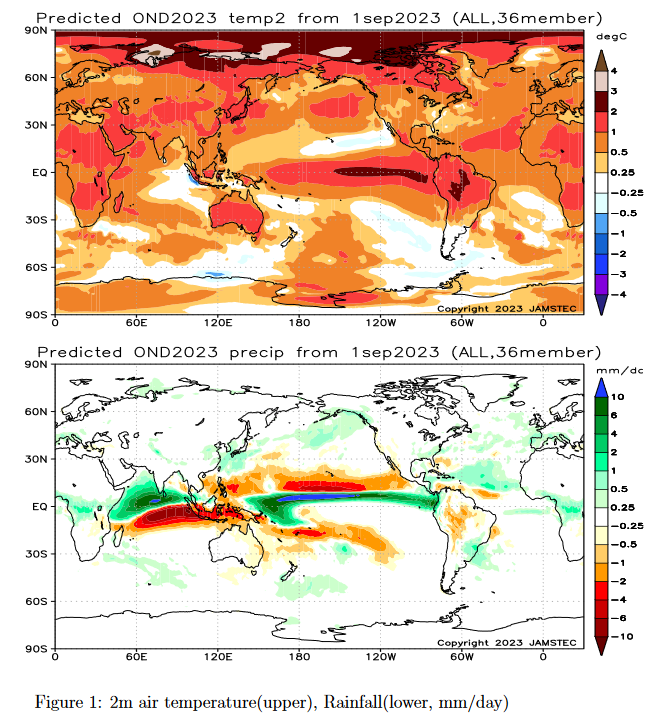
| The above covers October/November/ December (OND 2023)
Here is the interpretation from the JAMSTEC Discussion shown in the body of the article: “The SINTEX-F predicts that most parts of the globe will experience a hotter-than-normal condition in October–December. The Arctic region will experience extremely hotter-than-normal conditions. ” “As regards the rainfall in October–December, a drier-than-normal condition is predicted for a western coastal part of the U.S.A., Hawaii, many parts of the South American continent, eastern Australia, Tanzania, Indonesia, and the Philippines. In contrast, southern Alaska, the southeastern part of the U.S.A., some parts of the Caribbean, La Plata, Sri Lanka, Nepal, Bhutan, central and western Africa, Kenya, and some parts of East Asia will experience a wetter-than-normal condition. In particular, we notice that Indonesia and eastern Australia may experience extremely drier than normal conditions, owing to a combination of the positive Indian Ocean Dipole and the El Niño. It may increase the likelihood of bushfires in the countries in the coming season. Also, the positive Indian Ocean Dipole will be responsible for flooding in East African countries such as Kenya.” “The model predicts that most of Japan will be warmer than normal in the autumn and winter. The model also predicts that western Japan will be wetter than normal in the autumn and winter.” |
| The above covers December/January/February (DJF 2023-2024) which is meteorological Winter.
Here is the interpretation from the JAMSTEC Discussion shown below: “The model also predicts a similar condition [as in NDJ] in the boreal winter (austral summer), except for the eastern part of the U.S.A. ” “In the boreal winter (austral summer), a drier-than-normal condition is predicted for the western coastal areas of Canada, Hawaii, northern Brazil, some parts of the South American continent, northern Australia, the Philippines, and southern Africa. In contrast, southern Alaska, a southeastern part of the U.S.A., southern Brazil, Ecuador, Peru, some parts of La Plata, central Africa, western Madagascar, Nepal, Bhutan, some parts of Central Asia, most of East Asia, and some parts of Indonesia will experience a wetter-than-normal condition.” “The model predicts that most of Japan will be warmer than normal in the autumn and winter. The model also predicts that western Japan will be wetter than normal in the autumn and winter.” |
| And above, March/April/May (MAM) 2024 is meteorological Spring. JAMSTEC does not provide its interpretation of its third season but one can observe it on the maps. |
Now I am going to provide their single-month forecasts for October, November and December.
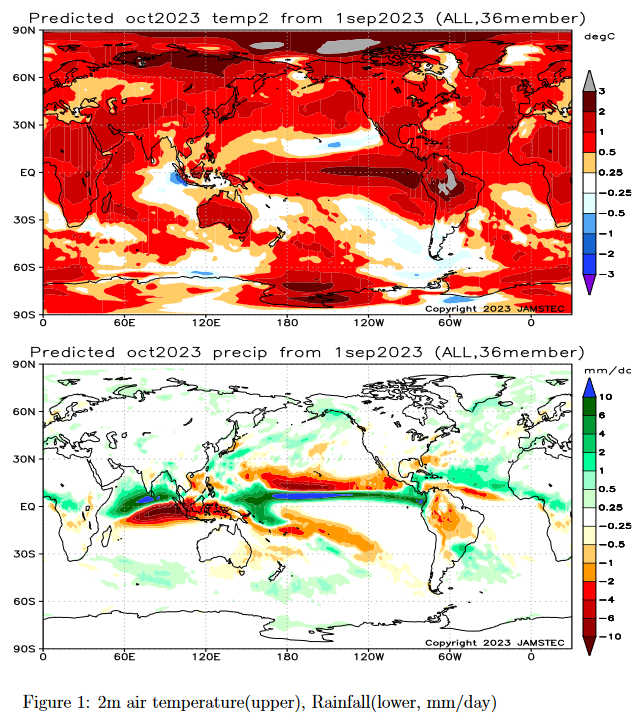
| The above is the single month of October 2023. |
| The above is the single month of November 2023. The Eastern U.S. suddenly becomes wet. |
| The above is the single month of December 2023. Now part of the Southwest is dry and the wet area for the Eastern U.S. is reduced to the Southeast. |
Now we look at the key indices used by JAMSTEC in making their forecast. Perhaps I should have presented these first.
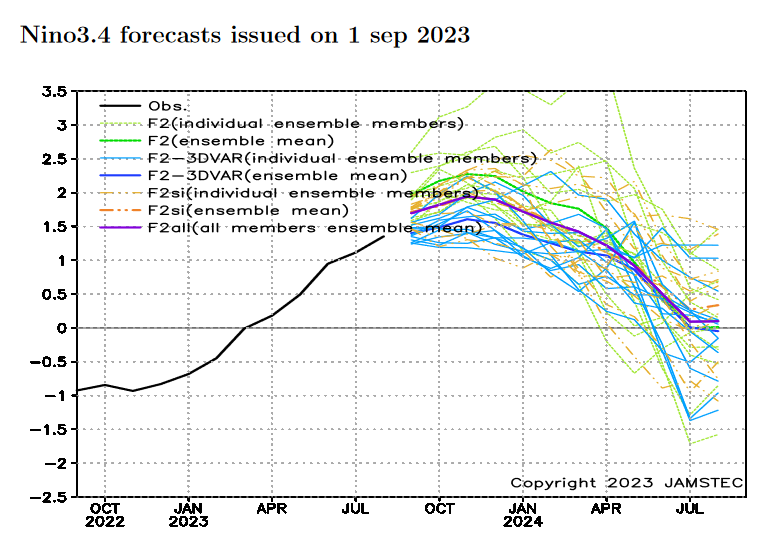
| This forecast (unlike the forecast last month) is for a fairly strong El Nino (Nino 3.4 approaching 2). It is forecasting a fairly rapid decline in the strength of the El Nino 3.4 Index. |
| I am showing the Modoki Index this month. The NINO 3.4 index starts to decline after about November as the El Nino moves west and takes on more of the characteristics of an El Nino Modoki for the second half of winter. |
| We are having a Positive IOD but it will end fairly soon. Below is shown the typical impact of a positive IOD. But the impacts can be complex. |
And here is the short JAMSTEC Discussion
ENSO forecast:
As predicted, the recent observation confirms the occurrence of the El Niño. The SINTEX-F ensemble mean predicts that the El Niño will reach its peak in the late boreal autumn and persist at least until the next boreal spring. However, there is a large uncertainty in the predicted amplitude.
Indian Ocean forecast:
As predicted, the recent observation confirms the development of a positive Indian Ocean Dipole event. The SINTEX-F predicts that the positive Indian Ocean Dipole will reach its peak in October and decay in the boreal winter. However, the model predicts that the warmer-than-normal temperature in the western Indian Ocean will persist through the boreal winter.
Regional forecast:
The SINTEX-F predicts that most parts of the globe will experience a hotter-than-normal condition in October–December. The Arctic region will experience extremely hotter-than-normal conditions. The model also predicts a similar condition in the boreal winter (austral summer), except for the eastern part of the U.S.A.
As regards the rainfall in October–December, a drier-than-normal condition is predicted for a western coastal part of the U.S.A., Hawaii, many parts of the South American continent, eastern Australia, Tanzania, Indonesia, and the Philippines. In contrast, southern Alaska, the southeastern part of the U.S.A., some parts of the Caribbean, La Plata, Sri Lanka, Nepal, Bhutan, central and western Africa, Kenya, and some parts of East Asia will experience a wetter-than-normal condition. In particular, we notice that Indonesia and eastern Australia may experience extremely drier than normal conditions, owing to a combination of the positive Indian Ocean Dipole and the El Niño. It may increase the likelihood of bushfires in the countries in the coming season. Also, the positive Indian Ocean Dipole will be responsible for flooding in East African countries such as Kenya.
In the boreal winter (austral summer), a drier-than-normal condition is predicted for the western coastal areas of Canada, Hawaii, northern Brazil, some parts of the South American continent, northern Australia, the Philippines, and southern Africa. In contrast, southern Alaska, a southeastern part of the U.S.A., southern Brazil, Ecuador, Peru, some parts of La Plata, central Africa, western Madagascar, Nepal, Bhutan, some parts of Central Asia, most of East Asia, and some parts of Indonesia will experience a wetter-than-normal condition.
The model predicts that most of Japan will be warmer than normal in the autumn and winter. The model also predicts that western Japan will be wetter than normal in the autumn and winter.
–
| I hope you found this article interesting and useful |
